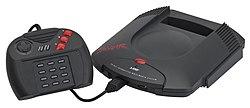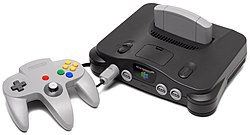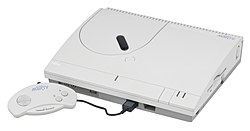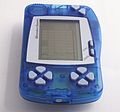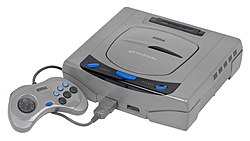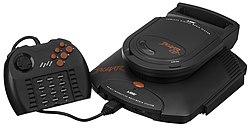History of video game consoles (fifth generation)
| Part of a series on: |
| History of video games |
|---|
The fifth generation of video game consoles began in 1993 and ended in 2003.[1] The fifth generation was also called the 32-bit, 64-bit or the 3D generation of video game consoles. Throughout the fifth generation, only three consoles were among the most popular video game consoles in this era. These consoles include, the Sega Saturn (1994), the Sony PlayStation (1994), and the Nintendo 64 (1996). In different parts of the world, console sales varied widely. However, the PlayStation was the best-selling system of the fifth generation. The 3DO, Atari Jaguar, Amiga CD32 and PC-FX and other consoles were also part of this generation. However, those systems were not very successful.
The handheld game consoles of the fifth generation were not that successful. The first handheld, Sega Nomad had a lifespan of two years. The Virtual Boy only had less than one year. Both of them were discontinued. Nintendo's Game Boy Color became the best-selling handheld video console of the fifth generation. There were two updated versions of the original Game Boy such as the Game Boy Light (Japan only) and the Game Boy Pocket.
The bit ratings of consoles in the 5th generation began to blur & were less of a selling feature than the previous "bit wars" of the 8 and 16 bit era. The number of "bits" in console names referred to the CPU word size. It had been used by hardware marketers as a "show of power" for many years. The fifth generation saw the increase of emulation. The development of the Internet made it possible to save and download tape and ROM images of older games. This led the seventh generation consoles to make many older games available for purchase or download.
Home systems
Comparison
| Name | 3DO Interactive Multiplayer | Atari Jaguar | Sega Saturn | PlayStation | Nintendo 64 |
|---|---|---|---|---|---|
| Developer | The 3DO Company | Atari | Sega | Sony | Nintendo |
| Console | +{{{1}}}−{{{2}}}+{{{1}}}−{{{2}}} | +{{{1}}}−{{{2}}}+{{{1}}}−{{{2}}} | +{{{1}}}−{{{2}}}+{{{1}}}−{{{2}}} | +{{{1}}}−{{{2}}}+{{{1}}}−{{{2}}} | +{{{1}}}−{{{2}}}+{{{1}}}−{{{2}}} |
| Launch prices (USD) | US$699.99[2] | US$249.99 | US$399.99[2] | US$299.99 | US$199[3] |
| Release date | NA October 4, 1993 JP March 20, 1994 EU 1994 |
NA November 15, 1993 JP November 21, 1994 EU Q4, 1994 |
JP November 22, 1994 NA May 11, 1995 EU July 8, 1995 |
3 December 1994 | JP June 23, 1996 NA September 29, 1996 EU March 1997 |
| Media | CD-ROM | Cartridge | CD-ROM, cartridge (limited, Japan only) | CD-ROM | Cartridge, (proprietary magnetic disk via Japan-only add-on) |
| Best-selling game | Virtua Fighter 2, 1.7 million in Japan[4] | Gran Turismo, 10.85 million shipped (as of April 30, 2008)[5][6] | Super Mario 64, 11.62 million (as of May 21, 2003)[7][8] | ||
| CPU | ARM60 32-bit RISC CPU at 12.5 MHz | "Tom" (26.6 MHz), "Jerry" (26.6 MHz) and a Motorola 68000 (13.3 MHz) | Two Hitachi SuperH-2 7604 32-bit RISC processors at 28.63 MHz | MIPS R3000A-compatible 32-bit RISC chip running at 33.8688 MHz | NEC VR4300 64-bit at 93.75 MHz |
| GPU | Two accelerated video co-processors | 5 processors contained in 3 chips: "Tom", "Jerry" and Motorola 68000 | Two custom 32-bit video display processors at 28.63 MHz | 66 MIPS vector math unit in the main CPU | Reality Co-Processor: MIPS R4000-based 8-bit integer vector processor at 62.5 MHz |
| Memory | 2MB RAM, 1MB VRAM | 2 MB of fast page mode DRAM(4 chips x 512 KB) | 1MB SDRAM, 1MB DRAM, 6x 512KB for 3D graphics, 3D frame buffers, 2D graphics, sound, CD subsystem, BIOS ROM | 2MB, 1MB VRAM, 512KB sound | 4MB (8MB with Expansion Pak) |
| Accessories (retail) |
|
|
| ||
| System sales (worldwide) |
2 million |
500,000 |
9.4 million |
102 million |
32.93 million |
Other consoles
| Name | FM Towns Marty | Pioneer LaserActive | Amiga CD32 | Neo Geo CD | PC-FX | Apple Bandai Pippin |
|---|---|---|---|---|---|---|
| Developer | Fujitsu | Pioneer | Commodore | SNK | NEC | Apple |
| Console | +{{{1}}}−{{{2}}}+{{{1}}}−{{{2}}} | +{{{1}}}−{{{2}}}+{{{1}}}−{{{2}}} | +{{{1}}}−{{{2}}}+{{{1}}}−{{{2}}} | +{{{1}}}−{{{2}}}+{{{1}}}−{{{2}}} | +{{{1}}}−{{{2}}}+{{{1}}}−{{{2}}} | +{{{1}}}−{{{2}}}+{{{1}}}−{{{2}}} |
| Launch prices | US$450 | ¥89,800, US$970 | US$500 | US$300 | US$250 | US$599 |
| Release date | JP February 20, 1993 |
JP August 20, 1993 NA September 13, 1993 |
NA September 16, 1993 |
September 9, 1994 EU1994 NA | JP December 20, 1994 | March 28, 1995 NA |
| Media | CD-ROM, 3½-inch floppy disk | Laserdisc | CD-ROM | CD-ROM | CD-ROM | CD-ROM |
- Non-mass-market systems
Worldwide sales
| Console | Units sold |
|---|---|
| PlayStation | 102.49 million shipped (as of March 31, 2007)[9] |
| Nintendo 64 | 32.93 million (as of March 31, 2005)[10] |
| Sega Saturn | 9.4 million (as of May 4, 2007)[2] |
| 3DO | 2 million (as of May 4, 2007)[2] |
| Atari Jaguar | 500,000 (as of May 15, 2007)[11] |
| Amiga CD32 | 100,000 |
| PC-FX | <100,000 |
| Apple Bandai Pippin | 42,000 (as of May 4, 2007)[12] |
Handheld systems
Sega Nomad
Released in 1995[source?]Virtual Boy
1995–1996[12]Game Boy Pocket
Released in 1996Game Boy Light
Released in April, 1998Game Boy Color
Released in November, 1998[13]Neo Geo Pocket
Released in 1998[source?]Neo Geo Pocket Color
Released in 1999WonderSwan
Released in 1999[source?]WonderSwan Color
Released in 2000
Milestone titles
- Crash Bandicoot
- Dragon Warrior VII
- Final Fantasy VII
- Gran Turismo
- GoldenEye 007
- Star Fox 64
- The Legend of Zelda: Ocarina of Time[14][15][16][17][18][19][20]
- Metal Gear Solid
- The Need for Speed
- Nights into Dreams...
- PaRappa the Rapper
- Perfect Dark[21][22][23]
- Nintendo's Pokémon titles for the Game Boy
- Super Mario 64
- Resident Evil
- Silent Hill
- Spyro the Dragon
- Tomb Raider[24]
History Of Video Game Consoles (fifth Generation) Media
References
- ↑ "System List". GameFAQs. Retrieved 2012-08-15.
- ↑ 2.0 2.1 2.2 2.3 Blake Snow (2007-05-04). "The 10 Worst-Selling Consoles of All Time". GamePro.com. p. 1. Archived from the original on 2008-09-05. Retrieved 2007-11-25.
- ↑ Welsh, Oli (2017-02-24). "A complete history of Nintendo console launches". Eurogamer. Retrieved 2020-01-11.
- ↑ "Japan Platinum Game Chart". The Magic Box. Archived from the original on 2007-12-13. Retrieved 2007-11-25.
{{cite web}}: CS1 maint: bot: original URL status unknown (link) - ↑ Sony Computer Entertainment (2008-05-09). "Gran Turismo Series Shipment Exceeds 50 Million Units Worldwide". Press release. Archived from the original on 2008-09-16. https://web.archive.org/web/20080916065905/http://asia.playstation.com/eng_hk/index.php?q=node%2F1517. Retrieved 2008-06-03.
- ↑ ""Gran Turismo" Series Software Title List". Polyphony Digital. April 2008. Archived from the original on 2007-02-06. Retrieved 2008-06-03.
- ↑ "Mario sales data". GameCubicle.com. Retrieved 2007-11-25.
- ↑ "All Time Top 20 Best Selling Games". 2003-05-21. Archived from the original on 2006-02-21. Retrieved 2007-11-25.
- ↑ "PlayStation Cumulative Production Shipments of Hardware". Sony Computer Entertainment Inc. Archived from the original on 2011-05-24. Retrieved 2008-03-22.
- ↑ "05 Nintendo Annual Report - Nintendo Co., Ltd" (PDF). Nintendo Co., Ltd. 2005-05-26. p. 33. Retrieved 2007-11-25.
- ↑ Greg Orlando (2007-05-15). "Console Portraits: A 40-Year Pictorial History of Gaming". Wired News. Condé Nast Publications. Retrieved 2008-03-23.
- ↑ 12.0 12.1 Blake Snow (2007-05-04). "The 10 Worst-Selling Consoles of All Time". GamePro.com. p. 2. Archived from the original on 2008-09-05. Retrieved 2007-11-25.
- ↑ "Nintendo Adds Color to Its "Rainbow" of Products With New Game Boy Color Titles". Business Wire. October 12, 1998. Archived from the original on 2015-10-16. Retrieved 2011-05-07.
- ↑ "The Legend of Zelda: Ocarina of Time reviews". Metacritic. Archived from the original on 2008-09-13. Retrieved 2008-11-26.
{{cite web}}: CS1 maint: bot: original URL status unknown (link) - ↑ "IGN Top 100 Games, #001-010 (2005)". IGN. Archived from the original on 2015-05-11. Retrieved 2008-11-26.
- ↑ "IGN Top 100 Games, #4 (2007)". IGN. Archived from the original on 2007-12-02. Retrieved 2008-11-26.
- ↑ "NP Top 200", Nintendo Power 200: 58–66, February 2006.
- ↑ "The Greatest 200 Games of Their Time", Electronic Gaming Monthly 200: February 2006.
- ↑ "All-Time Best Rankings". GameRankings. Archived from the original on 2016-06-24. Retrieved 2008-11-26.
- ↑ "Top 100 Games of All Time", Game Informer 36. August 2001.
- ↑ "Perfect Dark for Nintendo 64 Reviews, Ratings, Credits, and More - Metacritic". Archived from the original on 2010-11-25. Retrieved 2013-05-23.
- ↑ Perfect Dark - Nintendo 64 - IGN
- ↑ Perfect Dark XBLA Review - IGN
- ↑ "Record-Breaking Lara Croft Battles her Way Into New Guinness World Records", MCV. January 21, 2010.

